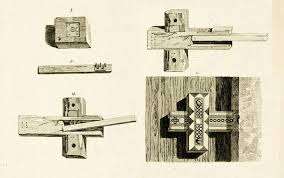Locks have played a pivotal role in human history, serving as guardians of privacy and property. The journey of lock development spans thousands of years, showcasing remarkable ingenuity and technological advancements. This article provides a historical overview of lock development, highlights key milestones, and explores how modern locks have evolved to meet contemporary security needs.
Ancient Beginnings: The Inception of Locks
Early Locks in Ancient Egypt
The earliest known locks date back to ancient Egypt around 4,000 years ago. These primitive locks were made of wood and operated with a simple pin tumbler mechanism. The lock consisted of a bolt and a set of wooden pins. The key, typically a wooden stick with pegs, would lift the pins to allow the bolt to move, unlocking the door. Although basic, this invention laid the foundation for future lock mechanisms.
Roman Innovations
The Romans improved upon the Egyptian design by introducing metal locks and keys. They created small, portable locks made of bronze and iron, which were used to secure chests and doors. The Romans also developed the warded lock, which used obstructions (wards) inside the lock to prevent the wrong key from turning. Only a key with the correct shape could navigate the wards and unlock the mechanism. This advancement increased the security and complexity of locks.
The Middle Ages: Advancements in Security
Medieval European Locks
During the Middle Ages, locksmithing became a specialised craft in Europe. Blacksmiths and artisans created intricate locks with elaborate designs. The introduction of the padlock, which could be easily transported and used on various items, marked a significant development. These locks featured a hinged shackle that could be fastened to a hasp and staple, securing doors, chests, and gates.
The Rise of the Mechanised Lock
In the 14th and 15th centuries, the mechanised lock emerged. These locks incorporated complex mechanisms, such as gears and levers, to enhance security. The combination lock, invented in the 17th century, allowed users to set a sequence of numbers or letters to unlock the device. These innovations demonstrated the growing sophistication of lock design and the increasing need for security in society.
The Industrial Revolution: Mechanisation and Mass Production
The Advent of Mass-Produced Locks
The Industrial Revolution brought significant advancements in lock manufacturing. The ability to mass-produce locks made them more affordable and accessible to the general public. Linus Yale Sr. and his son, Linus Yale Jr., were instrumental figures during this period. In 1848, Linus Yale Sr. invented the pin tumbler lock, inspired by the ancient Egyptian design. His son, Linus Yale Jr., refined the mechanism and created the modern cylinder lock, which became a standard in the industry.
The Introduction of the Yale Lock
The Yale lock, patented in 1861, featured a cylindrical key and a pin tumbler mechanism. This design provided enhanced security and ease of use. The lock’s key had serrated edges that aligned the pins at the correct height, allowing the cylinder to rotate and unlock the door. The Yale lock revolutionised the lock industry and set a new standard for residential and commercial security.
The 20th Century: Technological Innovations
The Rise of Electronic Locks
The 20th century saw the advent of electronic locks, which utilised electrical signals to control access. The invention of the electromagnetic lock, or maglock, in the 1970s, marked a significant milestone. Maglocks used an electromagnet and a metal armature plate to secure doors. When the electromagnet was energised, it created a strong magnetic field, holding the door firmly in place. Electronic locks offered convenience and enhanced security, particularly in commercial and industrial settings.
The Emergence of Keyless Entry Systems
Keyless entry systems gained popularity in the latter half of the 20th century. These systems eliminated the need for physical keys, relying instead on keypads, card readers, or biometric authentication. Keyless entry provided increased convenience and security, as access could be easily controlled and monitored. The development of radio-frequency identification (RFID) technology further improved keyless entry systems, allowing for seamless and contactless access.
The 21st Century: Smart Locks and Advanced Security
The Rise of Smart Locks
The 21st century has witnessed a surge in smart lock technology, integrating locks with digital and wireless capabilities. Smart locks can be controlled remotely via smartphones, tablets, or voice assistants. They often feature Wi-Fi, Bluetooth, or Zigbee connectivity, enabling users to lock and unlock doors from anywhere. Smart locks offer advanced features such as real-time notifications, temporary access codes, and integration with home automation systems.
Biometric Security
Biometric security has become a cornerstone of modern lock technology. Locks that utilise fingerprint, facial recognition, or retinal scans provide a high level of security and convenience. These locks authenticate users based on unique biological traits, making unauthorised access nearly impossible. Biometric locks are increasingly used in residential, commercial, and government applications, reflecting the demand for robust and foolproof security measures.
Enhanced Encryption and Cybersecurity
As locks become more connected and integrated with digital systems, cybersecurity has become a critical concern. Modern smart locks employ advanced encryption protocols to protect against hacking and unauthorised access. Manufacturers continuously update firmware and software to address vulnerabilities and enhance security. The integration of artificial intelligence (AI) and machine learning further strengthens the ability of locks to detect and respond to potential threats.
Conclusion
The evolution of locks from ancient times to the modern day is a testament to human ingenuity and the relentless pursuit of security. From the wooden pin tumbler locks of ancient Egypt to the sophisticated smart locks of today, each advancement has built upon the innovations of the past. Modern locks have evolved to meet contemporary security needs, incorporating electronic, keyless, and biometric technologies. As we move forward, the continued integration of advanced technologies and a focus on cybersecurity will shape the future of lock design, ensuring that our homes, businesses, and valuables remain protected.

